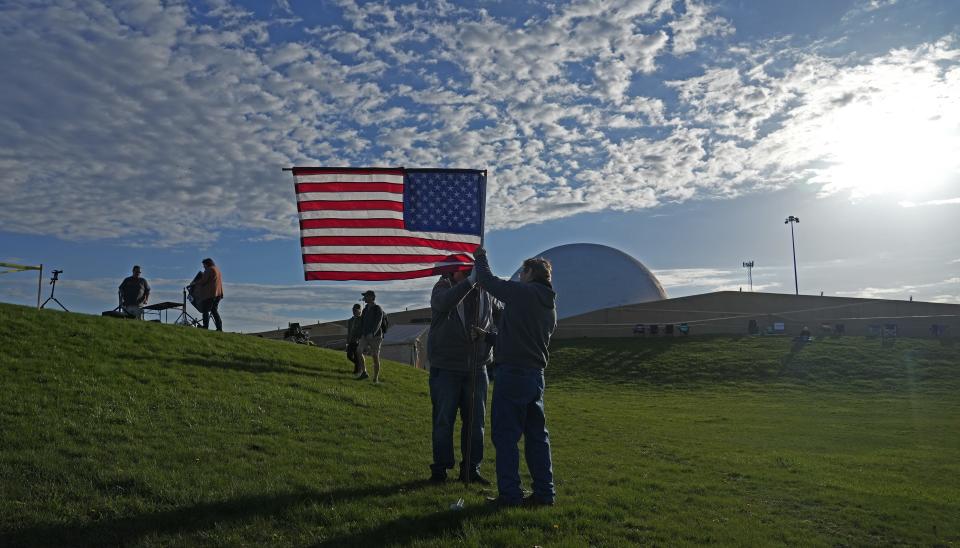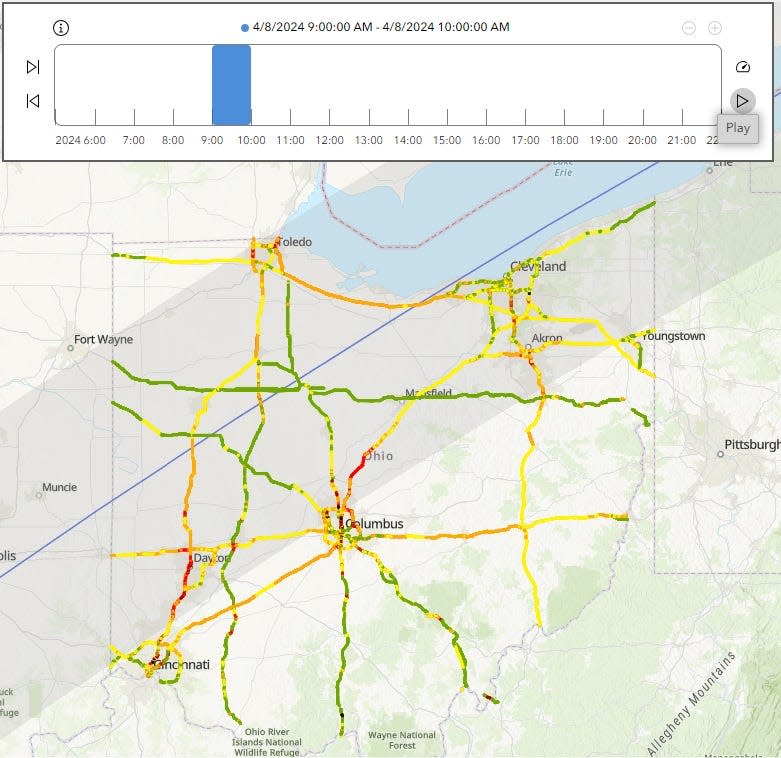Path of total solar eclipse to cross Ohio on Monday
The first total solar eclipse to cross Ohio in more than 200 years will occur Monday afternoon and millions throughout the state are expected to pause and look up as the moon blocks out the sun.
In the path of totality, which runs just northwest of here, the eclipse is expected to last approximately three minutes and 40 seconds.
With just hours until the eclipse crosses Ohio, here's everything you need to know to prepare for it.
Want to watch the eclipse live from Ohio? We've got you covered
The Dispatch will stream the total solar eclipse live this afternoon from the Armstrong Air and Space Museum in Wapakoneta.
In Wapakoneta, which is in the path of totality, the moon will start to cover the sun at about 1:54 p.m., with complete darkness running from 3:09 p.m. to 3:13 p.m. Full light will return at 4:25 p.m.
Stay tuned for live coverage of the eclipse all day.
—Doral Chenoweth, reporting from Wapakoneta, the hometown of Neil Armstrong, the first man on the moon.
Eclipse day festivities already underway along the path of totality
Tony Achilles, a radio producer at 89.5 WPKN, came from the Chicago area to the Armstrong Air and Space Museum in Wapakoneta, where he's been since Friday.
Set up on a small grassy hill, Achilles said he's going to capture video and sounds as the eclipse happens.
Looking up at the clear blue sky, Achilles said the weather is looking much better than he expected. But, he’s ready to head north if things look cloudy come eclipse time.

Achilles was one of hundreds of people at the museum, many in line to go inside when it opened at 9 a.m. There’s a line out to the adjacent Interstate 75 overpass to get into the museum parking lot and many people are walking around with blankets and camping chairs as they get ready for viewing.
Achilles came to Wapakoneta because it’s in the eclipse's path of totality. Here, viewers will get almost four minutes of the total eclipse, almost twice as long as in Dayton. Achilles also said Venus, Jupiter and possibly mercury should also be visible during the eclipse.
—Danae King, reporting from Wapakoneta, the hometown of Neil Armstrong, the first man on the moon.
Will any nocturnal animals come out during the eclipse?
While Ohioans are looking to the sky during the eclipse, they may also see some animals behaving strangely.
There's a long history of animals behaving strangely during solar eclipses and scientists at zoos have studied their behavior.
The shadow cast by the total solar eclipse could make some animals think it's dusk when it's really the afternoon.
At least 12 different nocturnal species may wake up along the eclipse's path of totality, according to the Ohio Division of Wildlife. Here's what animals Ohioans should be on the lookout for as the eclipse reaches its peak this afternoon.
Big Brown Bat
Striped Skunk
Raccoon
Barred Owl
Great Horned Owl
Northern Mockingbird
Northern Ring-necked Snake
Common Snapping Turtle
Spring Peeper
American Toad
Stinging Rose Caterpillar Moth
Rosy Maple Moth
—Max Filby, reporting from Columbus, which will experience 99% of the total eclipse.
It's eclipse day. Here's what National Weather Service says to expect in Ohio's path of totality
In Columbus, eclipse watchers can expect mostly sunny skies, with a high near 73 degrees.
In Cleveland, the largest city in the path of totality, viewers can expect it to be partly sunny with a high near 65 degrees, according to the National Weather Service (NWS).
Dayton, which is also in the eclipse's path, will see mostly sunny skies with a high near 74 degrees. Wapakoneta, the hometown of the first man on the moon Neil Armstrong, will experience a mostly sunny day with a high near 72 degrees.
—Max Filby, reporting from Columbus, which will experience 99% of the total eclipse.
Is ODOT reporting any traffic issues for the eclipse so far?
As of 9 a.m. Monday morning, the Ohio Department of Transportation had not reported any major highway congestion or traffic accidents as people descend on the eclipse's path of totality throughout Ohio.
But, that could change as the afternoon draws closer and following the eclipse, ODOT officials have said.
We’ve encouraged you to follow the Three Ps of #Eclipse24. First was Plan, then Prepare. Today — and this one is big — Patience! @OSHP_NWOhio pic.twitter.com/fzhOaKv27A
— ODOT Toledo (@ODOT_Toledo) April 5, 2024
Ohio will welcome hundreds of thousands of visitors for the eclipse today.
Between 150,000 to 575,000 people could arrive in the Buckeye state to watch the total solar eclipse cast its shadow over Ohio. And visitors will likely head to all different areas of the state, with the 124-mile-wide path of totality crossing Ohio from the southwest corner to the northeastern edge.
In central Ohio and southwestern parts of the state, drivers may experience some gridlock in the morning, according to the Ohio Department of Transportation.
But the biggest traffic backups could occur once the eclipse ends.

The heaviest flow of traffic is forecast to hit the roads in the afternoon, according to ODOT. Some of Ohio's most major highways could be backed up for hours as people head home after the eclipse, the agency has said.
The worst of the highway congestion could occur in northwest Ohio between Toledo and Findlay, which is the closest viewing area for eclipse chasers from Michigan. Portions of Interstate 71 and Interstate 270 in the Columbus area may also experience backups, according to ODOT.
ODOT's map of traffic forecasts for the solar eclipse is available online.
—Max Filby, reporting from Columbus, which will experience 99% of the total eclipse.
What time will the solar eclipse occur near me?
The total eclipse will last for only a few minutes, making it important to know exactly when to stop and look up toward the sky.
Although Columbus is just outside the path of totality, the city will still get to see roughly 99% of the total eclipse. The moon will begin to pass over the sun at 1:55 p.m. in Columbus and the eclipse is expected to peak at 3:12 p.m. in the capitol city with the moon moving past the sun by 4:26 p.m.
Cleveland, the largest Ohio city in the path of the eclipse, will experience the peak between 3:13 p.m. and 3:17 p.m., according to NASA.
Use the ZIP code tracker below to find out when the eclipse begins, ends and reaches a peak in your neighborhood.
—Max Filby, reporting from Columbus, which will experience 99% of the total eclipse.
![Swaraj Patel, 18, takes a photo of the eclipse on his smartphone through a pair of solar glasses Aug. 21 at an eclipse-viewing party held at Penn State Behrend in Harborcreek Township. Patel is a sophomore computer engineering student from India. Hundreds turned out for the event at Behrend, which featured telescopes fitted with solar filters available for viewing the partial eclipse. [CHRISTOPHER MILLETTE/ERIE TIMES-NEWS]](https://s.yimg.com/ny/api/res/1.2/bP0.O.7UF2BAQpqvyu3Dbw--/YXBwaWQ9aGlnaGxhbmRlcjt3PTk2MDtoPTY5Ng--/https://media.zenfs.com/en/times-recorder/6a0a28ace2af18faa553c0100ba7e916)
This article originally appeared on The Columbus Dispatch: Total eclipse to cross through Ohio on Monday

